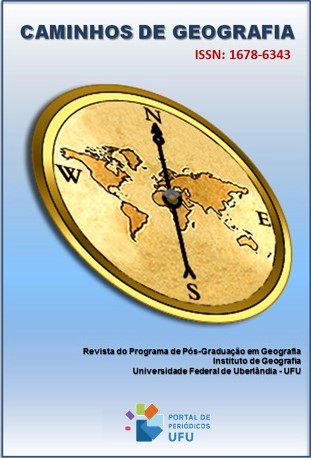SPATIAL RELATIONSHIP BETWEEN WATER CONDITION AND NATIVE VEGETATION FORMATIONS THROUGH SPECTRAL INDEXES
DOI:
https://doi.org/10.14393/RCG249161230Keywords:
Remote Sensing, NDWI, Water ContentAbstract
Collection of information present in the vegetation is crucial to analyze its characteristics and understand its behavior in forest environments. One of the ways to obtain this information is remote sensing techniques, which enables spatial and time analysis of the components of the terrestrial surface, among them the different vegetation forms and their characteristics. The aim of this study was to analyze the water status of different native vegetation formation through spectral indexes, aiming to identify which Normalized Water Difference Indices (NDWI) are more correlated to the expression of the Normalized Vegetation Difference Index (NDVI) used (MCFEETERS, 1996; GAO, 1996; e ROGERS and KEARNEY, 2004) for rainy and dry seasons. Images of Landsat-8 satellite were obtained for the rainy and dry period in areas of dense, open and herbaceous Caatinga, Mangrove and Atlantic Forest stricto sensu, extracting the NDVI and correlating it to different NDWI equations. The McFeeters equation stood out as the one that presented values most correlated to the NDVI, followed by that of Gao, for the forest types studied for both rainfall seasons, indicating the potential use of these equations in the studies of these vegetations.
Downloads
Downloads
Published
Issue
Section
License
Copyright (c) 2023 Janisson Batista de Jesus, Bruno Barros de Souza, Dráuzio Correia Gama

This work is licensed under a Creative Commons Attribution-NonCommercial-NoDerivatives 4.0 International License.
Autores que publicam nesta revista concordam com os seguintes termos: a) Autores mantém os direitos autorais e concedem à revista o direito de primeira publicação, com o trabalho licenciado sob a Creative Commons Atribuição-NãoComercial-SemDerivações 4.0 Internacional. b) Autores têm permissão e são estimulados a publicar e distribuir seu trabalho online (ex.: em repositórios institucionais ou na sua página pessoal), já que isso pode gerar alterações produtivas, bem como aumentar o impacto e a citação do trabalho publicado. c) Em virtude de aparecerem nesta revista de acesso público, os artigos são de uso gratuito, com atribuições próprias, em aplicações educacionais e não-comerciais.










